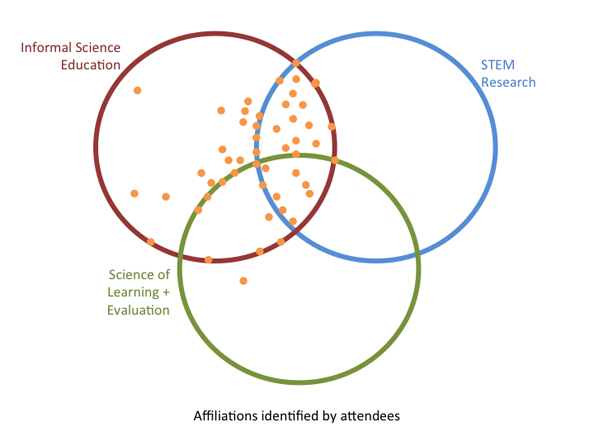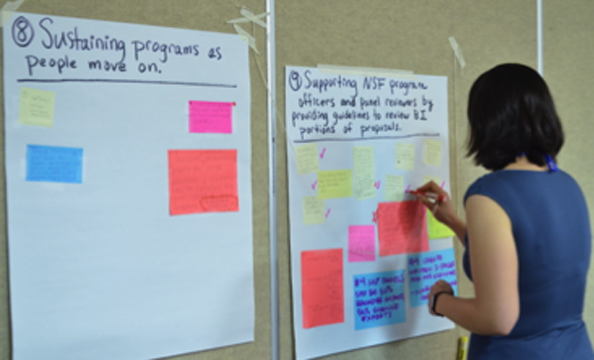Broader Impacts + Informal STEM Education = Opportunities!
Funding proposals to the U.S. National Science Foundation (NSF) undergo a peer review process that requires panels to consider the intellectual merit and broader impacts of the proposed research. Informal STEM education (ISE) offers opportunities for scientists and directors of outreach, education, engagement and communication to plan, propose, develop and collaborate on innovative broader impacts strategies and activities. Since 2012, the Center for Advancement of Informal Science Education (CAISE) has been connecting the scientific community to ISE projects, evaluators and researchers, collecting and curating web resources, giving presentations/posters at scientific society meetings, raising awareness via relevant publications and convening stakeholders to share results and discuss issues. 
In April 2015 CAISE brought together representatives from NSF-funded centers and large facilities with ISE professionals, evaluators and social science researchers for two days of exploration of the needs, opportunities and challenges of those researching, designing and evaluating education, engagement and broader impacts strategies. Participants also included leaders from the National Alliance for Broader Impacts (NABI) the American Association for the Advancement of Science (AAAS)Center for Public Engagement with Science and Technology and the American Society for Biochemistry and Molecular Biology (ASBMB). Among the highest priority needs identified were enhanced awareness of existing and potential networks, dedicated brokers and backbone organizations to support such networks and the creation of a database of potential broader impacts/informal STEM education-savvy reviewers for NSF panels. Other valuable needs that surfaced included access to vetted, relevant literature on what types of informal STEM learning strategies, and collaborations between directors of education, outreach and ISE providers have been effective and replicable, and a database of such providers organized by region. 
Outputs from the convening are informing current and in-development efforts by CAISE and others that address some of these areas of need. An interactive Google map of participating NSF-funded centers and large facilities, with proximal ISE providers, is a starting point for identifying existing and potential connections. The 3rd annual NABI Summit, which followed the CAISE convening by 3 weeks, built on discussions that continued beyond the convening and resulted in the initiation of an evaluation working group that is drafting a guiding document designed to assist program directors and proposal review panels in evaluating the BI component of NSF proposals. The new AAAS science communication and collaboration platform called Trellis has a Groups functionality where Public Engagement with Science (a group now accepting members) and NABI Groups have been actively beta testing discussions on related topics.
Parallel to this, relevant activities in the ISE field continue to expand. The Building with Biology project spawned by members of the Nanoscale Informal Science Education Network (NISENet), a network that has been cultivated and nurtured for over 10 years, leverages the strength of those connections between scientists and ISE institutions to engage the public around the emerging field of synthetic biology. The Science Festival Alliance’s 4th International Public Science Events (IPSEC) conference held earlier this month was preceded by a Science Live workshop where issues of enhanced connectivity and comparative evaluation across different types of events in this rapidly-growing sector were discussed in depth. Portal to the Public is currently offering a limited number of one-time awards of up to $5,000 to PoPNet institutions to support initiatives by partners to develop replicable resources and strategies to engage local audiences and researchers in face-to-face dialogue. Proposals are due July 15, 2015.
Watch the informalscience.org website and this newsletter for other forthcoming outputs from the Broader Impacts + Informal Science Education work, including a white paper this fall.